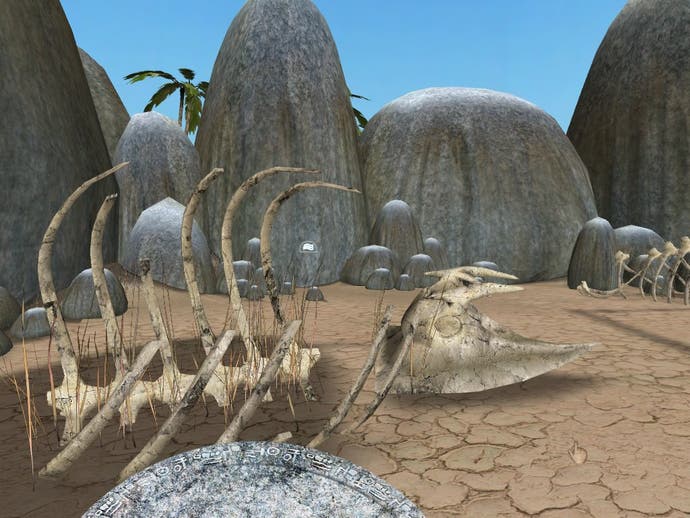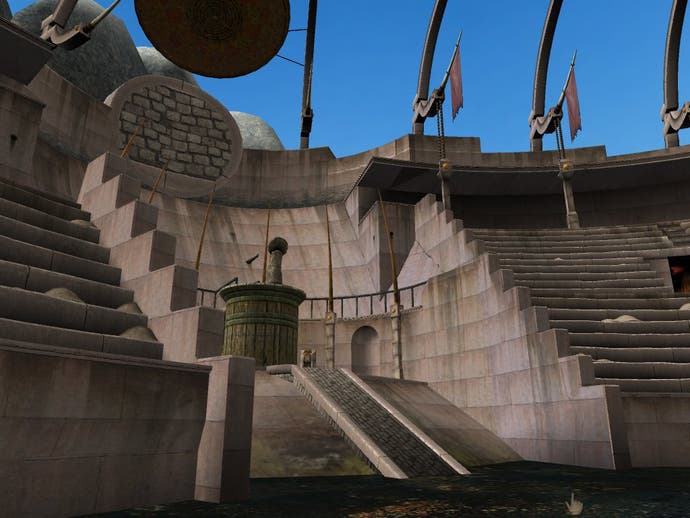Myst V: End of Ages
Myst again? Aha.
Most of us that love videogames will have found ourselves defending them at some point with the old "they teach valuable problem-solving skills" line. "Kids aren't stuck inside gloomy bedrooms wallowing in meaningless and mechanical slaughter; they are learning the lateral thinking and logical rigour that will equip them for the arduous odyssey that is Life!" Normally you trot this argument out and frailer, less confident opponents wilt or begin to back-pedal. Few debaters are actually sufficiently well-informed to point-out that most game brainteasers wouldn't trouble an unusually dense baboon.
If your verbal sparring partner is aware of this shameful truth then there's always the old Myst gambit: "I'd like to see the unusually dense baboon that could think there way through baffling adventure games like the Myst series!" On extremely rare occasions your opponent may leave the room for a few moments reappearing with a triumphant grin and an unusually dense Myst-proficient baboon but generally this is checkmate. Who could possibly accuse videogames of mushing the minds of their users when there are mental assault courses like Myst around?
Myst V is all about the puzzles. Like its predecessors, play consists largely of wandering around bizarre, beautiful lands attempting to solve complex mechanical conundrums. To make progress you'll need to be methodical, mathematical, observant and above-all, very patient. Even old-hands can expect to spend hours deciphering some of the fiendish devices in this game. What does this lever do? Why does that symbol appear when I press this button? How do I move that cog? Why didn't the engineers that built this thing leave a flippin' manual? Expect a constant stream of these types of questions.

The biggest departure in Myst V is that many of the puzzles can't be solved alone. Assistance must be sought from the shy Bahro - a race of spell-weaving bipedal reptiles that scamper around the six 'Ages' (lands) in the game. Being Myst you cant just stroll up to one of these scaly fellows and ask them for a hand. They have to be encouraged to appear and perform with the aid of the new drawing slates - stone tablets on which you scribe (and erase) various arcane symbols. Again, being Myst, you don't get handed the Idiot's Guide To Bahro Pictograms at the start of play. It's up to you to find symbols in the various environments and figure-out when to use them.
The slate calligraphy sometimes has to be rather too precise but overall it's a nice enhancement to an increasingly tired 10+ year-old formula. Myst has traditionally been a lonely game and the occasional appearance of a friendly lizard-man helps to alleviate this a little. The only other intelligent beings you'll encounter on your journey are Yeesha, the daughter of series star Atrus, and Esher, a sneery self-appointed advisor with mysterious motives. Both want you to succeed in your quest - freeing a power-bestowing tablet - by completing the challenges in the various Ages. Both, naturally, have their own agendas which gradually become clearer as you progress.

In previous episodes, encounters with characters like Yeesha and Esher would have taken the form of dodgy FMV cut-scenes. In End of Ages you actually get to see them strutting around in front of you as masterfully motion-captured polygonal figures. Expressive faces, decent lip-synching, naturalistic gestures, swaying robes... it's not quite Half Life 2 but their presence is pretty impressive all the same. Voice talent is top drawer too. Remember Major Winchester from Korean war sitcom M.A.S.H? The actor that plays him voices Esher. Remember the woman that played Daisy Duke in The Dukes of Hazzard? Sensibly she wasn't chosen to play the role of Yeesha.
The style of the dialogue and journal entries (as you explore you find diaries that provide clues and fill-in back story) in Myst V is not going to be to everyone's taste. Bland and vapid, it's criminally short of memorable phrases and humour. It would be far easier to love this series if it occasionally pricked its own pomposity.

One thing you've never been able to accuse a Myst game of is ugliness. Whether pre-rendered, as in the early titles, or fully 3D as they are now, the atmospheric dream-like worlds have always been breathtaking. In End of Ages you'll explore strange tropical islands littered with bizarre skeletons, towering lunar escarpments topped with giant astronomical instruments, and vast cathedral-sized caverns before you reach the dilemma that ends the game and the entire series. As stunning as these locations are they do have their immersion-sapping inconsistencies. Direbo, the gloomy swamp 'hub' world features four islands linked by four gated bridges. Logic would suggest that you could hop over the low bridge gates but in fact it isn't possible. One challenge I've just completed involved using a counterweight to lift a pillar up to the level of a platform. Get the sums wrong and you end-up standing on the pillar a couple of feet above the platform. Again common sense and FPS experience would suggest that you could jump down but in fact the game forbids it.
Talking of FPS conventions, the other big change in End of Ages is the movement system. Now, if you wish to, you can abandon the awkward click-and-glide technique (click to move between various fixed locations) and opt for much more natural WASD walking. This makes the exploring that is so crucial to the game a lot more pleasurable but it may also leave you itching for the firearms that Myst V so studiously boycotts. (We're still hoping that Cyan has snuck in a Bahro hunting mini-game somewhere).
With this episode the Myst series goes out in respectable fashion. There's still nothing on offer for anyone that craves action, exhilaration or an easy ride but frankly that's no great surprise.
